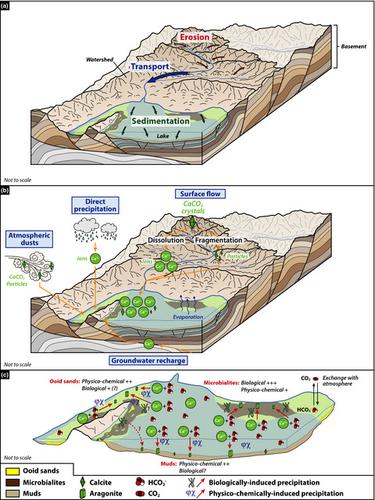当前位置:
X-MOL 学术
›
Basin Res.
›
论文详情
Our official English website, www.x-mol.net, welcomes your
feedback! (Note: you will need to create a separate account there.)
Prediction of the calcium carbonate budget in a sedimentary basin: A “source‐to‐sink” approach applied to Great Salt Lake, Utah, USA
Basin Research ( IF 2.8 ) Pub Date : 2019-10-20 , DOI: 10.1111/bre.12412 Anthony Bouton 1 , Emmanuelle Vennin 1 , Philippe Amiotte‐Suchet 1 , Christophe Thomazo 1 , Jean‐Pierre Sizun 2 , Aurélien Virgone 3 , Eric C. Gaucher 3 , Pieter T. Visscher 1, 4
Basin Research ( IF 2.8 ) Pub Date : 2019-10-20 , DOI: 10.1111/bre.12412 Anthony Bouton 1 , Emmanuelle Vennin 1 , Philippe Amiotte‐Suchet 1 , Christophe Thomazo 1 , Jean‐Pierre Sizun 2 , Aurélien Virgone 3 , Eric C. Gaucher 3 , Pieter T. Visscher 1, 4
Affiliation

|
[This study implemented a source‐to‐sink approach for the Great Salt Lake (GSL) hydro‐geosystem of the calcium dynamics, highlighting the dissolved pool in both the waterbody and the watershed. Major and minor pathways of calcium inputs were evaluated in order to quantify calcium delivered to the GSL during the Holocene. The value resulting from the hydrologic data was compared to the amount of calcium stored in the water column and sediments of the lake during the same period. The similarity between these two estimates is consistent with the premise of the source‐to‐sink approach: a mass balance between eroded and transported compounds and the sinks. The amount of calcium deposited in the basin can therefore be predicted indirectly from the different inputs. Alternative properties can be used to estimate the inputs in the fossil record when monitoring is unavailable. , Abstract Most source‐to‐sink studies typically focus on the dynamics of clastic sediments and consider erosion, transport and deposition of sediment particles as the sole contributors. Although often neglected, dissolved solids produced by weathering processes contribute significantly in the sedimentary dynamics of basins, supporting chemical and/or biological precipitation. Calcium ions are usually a major dissolved constituent of water drained through the watershed and may facilitate the precipitation of calcium carbonate when supersaturating conditions are reached. The high mobility of Ca2+ ions may cause outflow from an open system and consequently loss. In contrast, in closed basins, all dissolved (i.e. non‐volatile) inputs converge at the lowest point of the basin. The endoreic Great Salt Lake basin constitutes an excellent natural laboratory to study the dynamics of calcium on a basin scale, from the erosion and transport through the watershed to the sink, including sedimentation in lake's waterbody. The current investigation focused on the Holocene epoch. Despite successive lake level fluctuations (amplitude around 10 m), the average water level seems to have not been affected by any significant long‐term change (i.e. no increasing or decreasing trend, but fairly stable across the Holocene). Weathering of calcium‐rich minerals in the watershed mobilizes Ca2+ ions that are transported by surface streams and subsurface flow to the Great Salt Lake (GSL). Monitoring data of these flows was corrected for recent anthropogenic activity (river management) and combined with direct precipitation (i.e. rain and snow) and atmospheric dust income into the lake, allowing estimating the amount of calcium delivered to the GSL. These values were then extrapolated through the Holocene period and compared to the estimated amount of calcium stored in GSL water column, porewater and sediments (using hydrochemical, mapping, coring and petrophysical estimates). The similar estimate of calcium delivered (4.88 Gt) and calcium stored (3.94 Gt) is consistent with the premise of the source‐to‐sink approach: a mass balance between eroded and transported compounds and the sinks. The amount of calcium deposited in the basin can therefore be predicted indirectly from the different inputs, which can be assessed with more confidence. When monitoring is unavailable (e.g. in the fossil record), the geodynamic context, the average lithology of the watershed and the bioclimatic classification of an endoreic basin are alternative properties that may be used to estimate the inputs. We show that this approach is sufficiently accurate to predict the amount of calcium captured in a basin and can be extended to the whole fossil record and inform on the storage of calcium.]
中文翻译:

沉积盆地碳酸钙收支预测:适用于美国犹他州大盐湖的“源-汇”方法
[本研究对大盐湖 (GSL) 水文地质系统的钙动力学实施了一种源到汇的方法,突出了水体和流域中的溶解池。评估钙输入的主要和次要途径,以量化全新世期间输送到 GSL 的钙。将水文数据得出的值与同期储存在水体和湖泊沉积物中的钙量进行比较。这两个估计之间的相似性与源到汇方法的前提一致:侵蚀和运输的化合物与汇之间的质量平衡。因此,可以根据不同的输入间接预测盆地中沉积的钙量。当监测不可用时,替代属性可用于估计化石记录中的输入。, 摘要 大多数源汇研究通常关注碎屑沉积物的动力学,并将沉积物颗粒的侵蚀、迁移和沉积视为唯一的贡献者。虽然经常被忽视,但风化过程产生的溶解固体对盆地的沉积动力学有重要贡献,支持化学和/或生物降水。钙离子通常是通过分水岭排出的水的主要溶解成分,并且在达到过饱和条件时可能促进碳酸钙的沉淀。Ca2+ 离子的高迁移率可能会导致从开放系统中流出,从而导致损失。相反,在封闭盆地中,全部溶解(即 非易失性)输入会聚在盆地的最低点。内陆大盐湖盆地构成了一个极好的天然实验室,可以在盆地尺度上研究钙的动态,从侵蚀和通过流域到汇的迁移,包括湖泊水体中的沉积。目前的调查集中在全新世时期。尽管湖水位连续波动(幅度在 10 m 左右),平均水位似乎没有受到任何显着的长期变化的影响(即没有增加或减少的趋势,但在整个全新世相当稳定)。流域中富含钙的矿物质的风化动员了 Ca2+ 离子,这些离子通过地表流和地下流传输到大盐湖 (GSL)。这些流量的监测数据根据最近的人为活动(河流管理)进行了修正,并结合了直接降水(即雨和雪)和进入湖泊的大气灰尘收入,从而可以估计输送到 GSL 的钙量。然后将这些值外推到全新世时期,并与 GSL 水柱、孔隙水和沉积物中储存的估计钙量进行比较(使用水化学、绘图、取芯和岩石物理估计)。对输送的钙 (4.88 Gt) 和储存的钙 (3.94 Gt) 的类似估计与源到汇方法的前提一致:侵蚀和运输的化合物与汇之间的质量平衡。因此可以从不同的输入间接预测盆地中沉积的钙量,可以更自信地进行评估。当监测不可用时(例如在化石记录中),地球动力学背景、流域的平均岩性和内陆盆地的生物气候分类是可用于估计输入的替代属性。我们表明,这种方法足够准确,可以预测盆地中捕获的钙量,并且可以扩展到整个化石记录,并为钙的储存提供信息。]
更新日期:2019-10-20
中文翻译:

沉积盆地碳酸钙收支预测:适用于美国犹他州大盐湖的“源-汇”方法
[本研究对大盐湖 (GSL) 水文地质系统的钙动力学实施了一种源到汇的方法,突出了水体和流域中的溶解池。评估钙输入的主要和次要途径,以量化全新世期间输送到 GSL 的钙。将水文数据得出的值与同期储存在水体和湖泊沉积物中的钙量进行比较。这两个估计之间的相似性与源到汇方法的前提一致:侵蚀和运输的化合物与汇之间的质量平衡。因此,可以根据不同的输入间接预测盆地中沉积的钙量。当监测不可用时,替代属性可用于估计化石记录中的输入。, 摘要 大多数源汇研究通常关注碎屑沉积物的动力学,并将沉积物颗粒的侵蚀、迁移和沉积视为唯一的贡献者。虽然经常被忽视,但风化过程产生的溶解固体对盆地的沉积动力学有重要贡献,支持化学和/或生物降水。钙离子通常是通过分水岭排出的水的主要溶解成分,并且在达到过饱和条件时可能促进碳酸钙的沉淀。Ca2+ 离子的高迁移率可能会导致从开放系统中流出,从而导致损失。相反,在封闭盆地中,全部溶解(即 非易失性)输入会聚在盆地的最低点。内陆大盐湖盆地构成了一个极好的天然实验室,可以在盆地尺度上研究钙的动态,从侵蚀和通过流域到汇的迁移,包括湖泊水体中的沉积。目前的调查集中在全新世时期。尽管湖水位连续波动(幅度在 10 m 左右),平均水位似乎没有受到任何显着的长期变化的影响(即没有增加或减少的趋势,但在整个全新世相当稳定)。流域中富含钙的矿物质的风化动员了 Ca2+ 离子,这些离子通过地表流和地下流传输到大盐湖 (GSL)。这些流量的监测数据根据最近的人为活动(河流管理)进行了修正,并结合了直接降水(即雨和雪)和进入湖泊的大气灰尘收入,从而可以估计输送到 GSL 的钙量。然后将这些值外推到全新世时期,并与 GSL 水柱、孔隙水和沉积物中储存的估计钙量进行比较(使用水化学、绘图、取芯和岩石物理估计)。对输送的钙 (4.88 Gt) 和储存的钙 (3.94 Gt) 的类似估计与源到汇方法的前提一致:侵蚀和运输的化合物与汇之间的质量平衡。因此可以从不同的输入间接预测盆地中沉积的钙量,可以更自信地进行评估。当监测不可用时(例如在化石记录中),地球动力学背景、流域的平均岩性和内陆盆地的生物气候分类是可用于估计输入的替代属性。我们表明,这种方法足够准确,可以预测盆地中捕获的钙量,并且可以扩展到整个化石记录,并为钙的储存提供信息。]











































 京公网安备 11010802027423号
京公网安备 11010802027423号